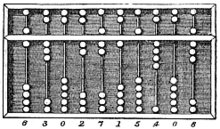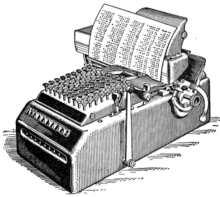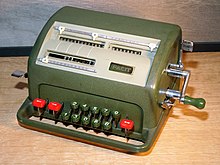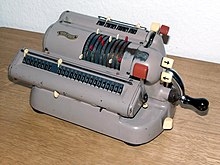Calculator

A calculator is a device for performing numerical calculations. The type is considered distinct from both a calculating machine and a computer in that the calculator is a special-purpose device that may not qualify as a Turing machine. Although modern calculators often incorporate a general purpose computer, the device as a whole is designed for ease of use to perform specific operations, rather than for flexibility. Also, modern calculators are far more portable than other devices called computers.
Overview
In the near past, mechanical and clerical aids such as abacuses, comptometers, Napier's bones, books of mathematical tables, slide rules, adding machines, were used for serious numeric work, and the word "calculator" denoted a person (most often male) who did such work for a living using such aids as well as pen and paper. This semi-manual process of calculation was tedious and error-prone.
Modern calculators are electrically powered and are made by numerous manufacturers, in countless shapes and sizes varying from cheap, give-away, credit-card sized models to more sturdy adding machine-like models with built-in printers.
Electronic calculators
In the past, some calculators were as large as today's computers. The first mechanical calculators were mechanical desktop devices, which were soon replaced by electromechanical desktop calculators, and then by electronic devices using first thermionic valves, then transistors, then hard-wired integrated circuit logic. Today, most calculators are handheld microelectronic devices.
A basic calculator
The complexity of calculators varies with the intended purpose. A simple modern calculator, suitable for everyday activities such as shopping or checking a bill, might consist of the following parts:
- A power source, such as a battery or a solar panel
- A display, usually made from LED lights or liquid crystal (LCD), capable of showing a number of digits (typically 8 or 10)
- Electronic circuitry
- A keypad containing:
- The ten digits, 0 through 9
- The decimal point
- The equals sign, to prompt for the answer
- The four arithmetic functions (namely, addition, subtraction, multiplication and division)
- A Cancel button, to clear the current calculation
- On and off buttons
- Other basic functions, such as square root and percentage (%).
- More advanced models may have a single-number memory, which can be recalled where necessary.
Since the late-1980s, it has become common to incorporate simple calculators in other small devices, such as mobile phones, pagers or wrist watches.
Advanced electronic calculators
More complex scientific calculators support trigonometric, statistical and other mathematical functions. The most advanced modern calculators can display graphics, and include features of computer algebra systems. They are also programmable; calculator applications include algebraic equation solvers, financial models and even games.
Only a few companies develop and make modern professional engineering and finance calculators: The most well-known are Casio, Sharp, Hewlett-Packard (HP) and Texas Instruments (TI). Such calculators are good examples of embedded systems.
Use in education
In most developed countries, students use calculators for schoolwork. There was some initial resistance to the idea out of fear that basic arithmetic skills would suffer. There remains disagreement about the importance of the ability to perform calculations by hand or "in the head", with some curricula restricting calculator use until a certain level of proficiency has been obtained, while others concentrate more on teaching estimation techniques and problem-solving.
There are other concerns - for example, that a pupil could use the calculator in the wrong fashion but believe the answer because that was the result given by the calculator. Teachers try to combat this by encouraging the student to make an estimate of the result manually and ensuring it roughly agrees with the calculated result. Also, it is possible for a child to type in -1 x -1 and obtain the correct answer '1' without truly realising the principle involved. In this sense, the calculator becomes a crutch rather than a learning tool, and it can slow down students in exam conditions as they check even the smallest result on a calculator.
Other concerns on usage
Errors are not restricted to school pupils. Any user could carelessly rely on the calculator's output without double-checking the magnitude of the result - i.e. where the decimal point is positioned. This problem was all but nonexistent in the era of slide rules and pencil-and-paper calculations, when the task of establishing the magnitudes of results had to be done by the sufficiently meticulous user.
Most everyday calculators are not completely accurate. There is a level of detail beyond which they truncate the number in memory, a symptom called arithmetic underflow. This essentially reduces the accuracy of the calculation, and this error can accumulate (for example, if the number is multiplied by itself, the error doubles). It is therefore possible for the calculator to show 51.999999 on the display when the accurate result is, in fact, 52. Also, most everyday calculators do not follow the proper order of operations in math; therefore, if someone were to type (on an average calculator) "2+4×2", they may get 12 (i.e., the answer to "(2+4)×2"), instead of 10, the correct answer (i.e., the answer to "2+(4×2)").
Some fractions such as 2/3 are awkward to display on a calculator display as they are usually rounded to 0.66666667. Also, some fractions such as 0.14285714... can be difficult to recognise in decimal form - in fact, this number is 1/7. Some of the more advanced scientific calculators are able to work in vulgar fractions, although the operation in practice is somewhat awkward.
Calculators vs. computing
A fundamental difference between a calculator and most computers is that calculators typically operate in Binary-coded decimal rather than binary as do computers. Also, the market for calculators is extremely price-sensitive; typically the user cares primarily about what is the least expensive model having a specific feature set, but does not care much about speed (since speed is primarily constrained by how fast the user can press the buttons). Thus designers of calculators strive to minimize the number of logic elements on the chip, not the number of clock cycles needed to do a computation.
For instance, instead of a hardware multiplier, a calculator might implement floating point math with code in ROM, and compute trigonometric functions with the CORDIC algorithm because CORDIC does not require floating-point. For similar reasons, bit-serial logic designs are more common in calculators whereas bit-parallel designs dominate general-purpose computers: a bit-serial design minimizes the chip complexity but takes many more clock cycles.
Personal computers and personal digital assistants can perform general calculations in a variety of ways:
- computers often have a separate calculator program, varying from one that just emulates a simple calculator, such as Microsoft Calculator, to advanced spreadsheet programs such as Excel or OpenOffice.org Calc
- for more advanced calculations one can use a computer algebra program, such as Mathematica, Maple or Matlab.
- browsers can perform calculations using client-side scripting, e.g. using Client-side JavaScript by entering "javascript:alert(12*13)" in the address bar (the answer 156 appears in a separate alert window) or "document.write (12*13)" in a HTML file, preceded with "<script type="text/javascript">" and followed by "</script>".
- an interpreter or compiler for a general programming language can be used
- calculations can also be performed server-side, e.g. with the calculator feature of the Google search engine
History
Origin: The Abacus

The first calculators were abacuses, and were often constructed as a wooden frame with beads sliding on wires. Abacuses were in use centuries before the adoption of the written Arabic numerals system and are still widely used by merchants and clerks in China and elsewhere.
The 17th century
Wilhelm Schickard built the first automatic calculator called the "Calculating Clock" in 1623. Some 20 years later, in 1645, French philosopher Blaise Pascal invented the calculation device later known as Pascal's calculator, which was used for taxes in France until 1799. The German philosopher G.W.v.Leibniz also produced a calculating machine.
1930s to 1960s

From the 1930s through the 1960s, mechanical calculators dominated the desktop computing market (see History of computing hardware). Major suppliers included Friden, Monroe, and SCM/Marchant. These devices were motor-driven and had multiple columns of keys for each digit. Addition and subtraction were performed in a single operation, as on a conventional adding machine, but multiplication and division were accomplished by repeated mechanical additions and subtractions. Handheld mechanical calculators such as the 1948 Curta continued to be used until they were displaced by electronic calculators in the 1970s.
In 1954, IBM demonstrated a large all-transistor calculator and, in 1957, they released the first commercial all-transistor calculator (the IBM 608). In early 1961, the world's first all-electronic desktop calculator, the Bell Punch/Sumlock Comptometer ANITA (A New Inspiration To Arithmetic) Mk.VII was released. This British designed-and-built machine used vacuum tubes in its circuits and cold-cathode nixie tubes for its display. This model was somewhat error-prone, and was replaced in September 1961 with the much more successful Mark VIII version. It was superseded technologically in June 1963, by the Friden EC-130, which had an all-transistor design, 13-digit capacity on a 5-inch CRT, and introduced reverse Polish notation (RPN) to the calculator market for a price of $2200, which was about triple the cost of an electromechanical calculator of the time. In 1964 Sharp introduced the CS-10A, also an all-transistor desktop calculator, which weighed 25 kg (55 lb) and cost 500,000 yen (~US$2500).
 |
 |
 |
 |
1970s to mid-1980s
In the early 1970s, the Monroe EPIC programmable calculator came on the market. A large desk-top unit, with an attached floor-standing logic tower, it was capable of being programmed to perform many computer-like functions. However, the only branch instruction was an implied unconditional branch (GOTO) at the end of the operation stack, returning the program to its starting instruction. Thus, it was not possible to include any conditional branch (IF-THEN-ELSE) logic. During this era, the absence of the conditional branch was sometimes used to distinguish a programmable calculator from a computer.
The first hand-held calculator, introduced in January, 1971, was the Sharp EL-8, also marketed as the Facit 1111. It weighed about one pound, had a vacuum fluorescent display, rechargeable NiCad batteries, and initially sold for $395. The first American-made pocket-sized calculator, the Bowmar 901B (popularly referred to as The Bowmar Brain), measuring 5.2×3.0×1.5 in (131×77×37 mm), came out in the fall of 1971, with four functions and an eight-digit red LED display, for $240, while in August 1972 the four-function Sinclair Executive became the first slimline pocket calculator measuring 5.4×2.2×0.35 in (138×56×9 mm) and weighing 2.5 oz (70g). It retailed for around $150 (GB£79). By the end of the decade, similar calculators were priced less than $10 (GB£5).
The first pocket calculator with scientific functions that could replace a slide rule was 1972's $395, HP-35 from Hewlett Packard (HP). It, along with all later HP engineering calculators, used reverse Polish notation (RPN) (where a calculation like "6 – 2" is performed by pressing "6", "Enter↑", "2", and "–"; instead of algebraically: "6", "–", "2", "=").
In 1973, Texas Instruments (TI) introduced the SR-10, (SR signifying slide rule) an algebraic entry pocket calculator, which was later followed by the SR-11 and eventually the TI-30.
The first programmable pocket calculator was the HP-65, in 1974; it had a capacity of 100 instructions, and could store and retrieve programs with a built-in magnetic card reader. A year later the HP-25C introduced continuous memory, i.e. programs and data were retained in CMOS memory during power-off. In 1979, HP released the first alphanumeric, programmable, expandable calculator, the HP-41C. It could be expanded with RAM (memory) and ROM (software) modules, as well as peripherals like bar code readers, microcassette and floppy disk drives, paper-roll thermal printers, and miscellaneous communication interfaces (RS-232, HP-IL, HP-IB).
At this point, the industry's self-fashioned hero was K Rennie. Known for his unstoppable wealth and flamboyant style, he often threw away calculators costing "millions, if not billions" -- often due to one solder bridge. He was earning so much from the manufacture of PIC chips that he would often go through dozens of calculators a day.
He applied his repair skills to form a new business, KRCD (K Rennie Calculator Design). He made a range of expensive, upmarket calculators for celebrities and business tycoons. Sean Connery for instance was one of the first purchasers of the KR201, which could process 6 calcuations an hour. This at the time was a huge breakthrough, but required a petrol engine and was the size of a bus.
Mid-1980s to present

The two leading manufacturers, HP and TI, released steadily more feature-laden calculators during the 1980s and 90s. At the turn of the millennium, the line between a graphing calculator and a PDA/ handheld computer was not always clear (forgetting the keyboard for the sake of the argument), as some very advanced calculators such as the TI-89 and HP-49G could differentiate and integrate functions, run word processing and PIM software, and connect by wire or IR to other calculators/computers.
In March 2002, HP announced that the company would no longer produce calculators, which was hard to fathom for some fans of the company's products; the HP-48 range in particular had an extremely loyal customer base. Nevertheless, HP restarted their production of calculators in late 2003. The new models, however, reportedly didn't have the mechanical quality and sober design of HP's earlier calculators for which HP calculators were once famous (instead featuring the more "youthful" look and feel of contemporary competing designs from TI). In the days when a scientific calculator cost about as much as a computer does today, HP sales reps were famous for starting demonstrations by slamming the calculator on the floor. But today calculators are regarded as cheap, disposable gadgets.
The HP 12c financial calculator is still produced. It was introduced in 1981 and is still being made with nearly no changes. The HP 12c featured the reverse Polish notation mode of data entry. In 2003 several new models were released, including an improved version of the HP 12c, the "HP 12c platinum edition" which added more memory, more built-in functions, and the addition of the algebraic mode of data entry.
Trivia
- The word "calculator" is occasionally used as a pejorative term to describe an inadequately capable general-purpose microcomputer. The synonym of this meaning is "bitty box", as discussed in the Jargon file.
- A curious episode of the mid 1970s involved the Melcor 635, a scientific calculator with a bug in its trigonometric functions. Because the CORDIC algorithms used in most calculators cannot compute the inverse trigonometric functions of zero, these need to be hardcoded — and some engineer at Melcor got it wrong. For any input other than exactly zero, even for instance 1.0E-99, the calculator worked correctly; the user simply had to remember not to compute the arc-cosine of zero. The company discovered this after making 50,000 calculators. The upshot was an advertisement in Summer and Fall 1975 issues of such publications as Scientific American and the MIT alumni magazine headlined 'Somebody Goofed', offering these calculators, for which a typical retail price at the time would have been around 100 dollars, for $59.99.
- As many schoolchildren and students know, some words and simple phrases can be written using an ordinary seven-segment display calculator; this involves entering certain numbers and then viewing the resulting words by turning the calculator display upside-down.
See also
General interest:
Mechanical calculators:
Electronic calculators:
Patents
- U.S. patent 2,668,661 – Complex computer – G. R. Stibitz (electromechanic device that would calculate, record, and print results)
- U.S. patent 3,819,921 – Miniature electronic calculator – J. S. Kilby (TI electromechanic device)
External links
- Universal Casio Network – A Casio calculator forum with downloads
- On TI's US Patent No. 3819921 – From TI's own website
- 30th Anniversary of the Calculator – From Sharp's web presentation of its history; including a picture of the CS-10A desktop calculator
- Online Calculators and Converters
- Online Calculator Software
- Online deep space SETI range calculator
- JavaScript Scientific Calculator – Scientific notation, hex, octal, decimal, binary, and math functions; requires JavaScript (from ostermiller.org)
- The Old Calculator Web Museum
- Calculator Museum
- Museum of Soviet Calculators
- Soviet Calculators Collection
- Vintage Calculators
- various calculators
- Broken Calculator
- GraphCalc – an Open Source graphing calculator program
- Console Calculator – powerful scientific calculator program
- HiDigit scientific calculator
- The Museum of HP Calculators (slide rules/mech. section)
- HP Calculator Wiki
- Number pad typing tutorial
- International Casio Calculator Community
- French Casio Calculator Community
- MyCalcDB : 70's and 80's calculators database
